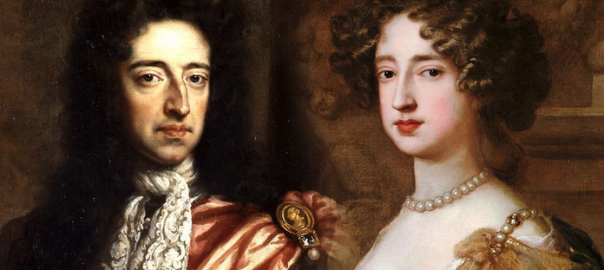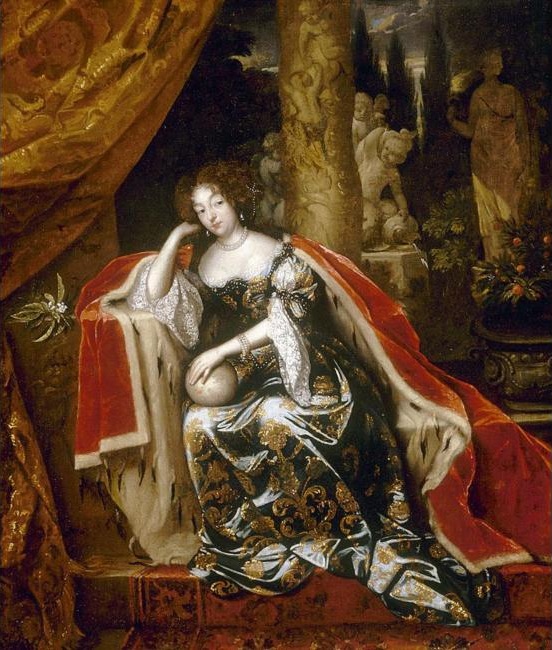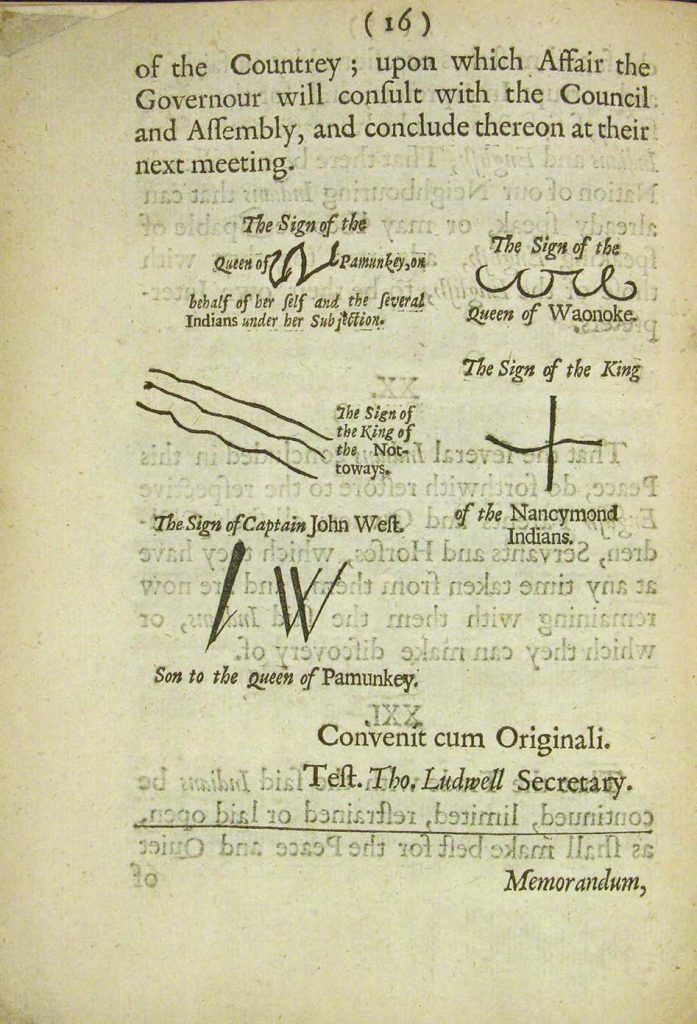It’s a mainly-Anglosphere post again today. I’ll look at two main history-of-imperialism items from 1677: the marrying of James, the Duke of York’s daughter Mary to William of Orange, and the Treaty concluded between Governor Berkeley of Virginia with “several Indian Kings and Queens, &c.” of that area.
In other world news, the Franco-Dutch war still continued, as did the war in the Baltic between the Dutch-Danish alliance and Sweden.
(Next year, we’ll go to Brazil and other non-Anglo places.)
Mary marries William
So here we were, just a few years after England’s King Charles II had signed the secret pact with France’s Louis XIV in which they agreed to make war on the Dutch UP’s together and to split up the spoils there between them, while Charles would secretly convert to Catholicism… But in the intervening years England’s Parliament had made quite clear to Charles that they would not support those moves or any like them.
Charles, you may recall, was childless. So his successor would be his slave-trading, rambunctious, profit-oriented, (and Catholic) brother James the Duke of York. James’s two children from his first (Protestant) wife were Mary, born 1662, and Anne, born 1665. Charles had insisted– perhaps under pressure from Parliament?– that they both be raised Protestant (Church of England).
In 1677, Charles arranged for Mary, now 15, to become engaged to William of Orange, the now 27-year-old Stadtholder of Holland. English-WP takes up the story:
William was the son of the [English] King’s late sister… and thus fourth in the line of succession after James, Mary, and Anne. At first, Charles II opposed the alliance with the Dutch ruler—he preferred that Mary wed the heir to the French throne, the Dauphin Louis, thus allying his realms with Catholic France and strengthening the odds of an eventual Catholic successor in Britain; but later, under pressure from Parliament and with a coalition with the Catholic French no longer politically favourable, he approved the proposed union. The Duke of York agreed to the marriage, after pressure from chief minister Lord Danby and the King, who incorrectly assumed that it would improve James’s popularity among Protestants. When James told Mary that she was to marry her cousin, “she wept all that afternoon and all the following day”.
William and a tearful Mary were married in St James’s Palace by Bishop Henry Compton on 4 November 1677. The bedding ceremony to publicly establish the consummation of the marriage was attended by the royal family, with the King himself drawing the bedcurtains. Mary accompanied her husband on a rough sea crossing to the Netherlands later that month, after a delay of two weeks caused by bad weather… On 14 December, they made a formal entry to The Hague in a grand procession.
Mary’s animated and personable nature made her popular with the Dutch people, and her marriage to a Protestant prince was popular in Britain. She was devoted to her husband, but he was often away on campaigns, which led to Mary’s family supposing him to be cold and neglectful. Within months of the marriage Mary was pregnant; however, on a visit to her husband at the fortified city of Breda, she suffered a miscarriage, which may have permanently impaired her ability to have children… Her childlessness would be the greatest source of unhappiness in her life.
Stay tuned to see what effect this dynastic marriage will have on relations between these two still harshly competing global empires.
Virginia’s (new) governor signs a treaty
In the 1676 bulletin, I recounted the story of “Bacon’s Rebellion”, an insurrection by English settler-extremists against the governor of the Virginia Colony, William Berkeley. And I took the story up to the point where Bacon’s insurrection had fallen apart and Berkeley had traveled back to England to try to defend his actions to the king. But he died in July 1677 before he could meet the king.
From this source, on the website “Virtual Jamestown”, I learned the following additional details:
Once reports of the revolt reached London, the crown sent 1,000 redcoats, ships, and a commission to crush Bacon and to inquire into the reasons for the tumult. Colonel Herbert Jeffreys, one of the commissioners, had orders to replace Berkeley. There was nothing for the troops to do because Berkeley had regained the upper hand. The rebellion ended before they arrived in January 1677. Jeffreys and his fellow commissioners soon quarrelled with Berkeley, who refused to give up the government. Finally, on 5 May 1677, he yielded, and he crossed the ocean one last time. The Treaty of Middle Plantation, the formal peace treaty between the Indians and the colonists, was signed on 29 May 1677, after Berkeley returned to England.
The full official record of this treaty, called “Articles of Peace” can be seen in facsimile and “modern-rendered” form at this page on the “Encyclopedia Virginia.” These Articles of Peace were concluded between:
the most Mighty Prince, and our Dread Sovereign Lord CHARLES the Second, by the Grace of God, King of Great Britain, France and Ireland, Defender of the Faith, &c. And the several Indian Kings and Queens, &c. Assenters and Subscribers hereunto, made and concluded at the Camp at Middle Plantation the Twenty ninth day of May 1677. being the day of the most happy Birth and Restauration of our said Sovereign Lord, and in the Nine and twentieth Year of His Majesties Reign, By the Right Honourable Herbert Jefferies Esquire, Lieutenant-Governour of His Majesties Colony of Virginia.
So there, “Jefferies” was described only a “Lieutenant-governour”, not “governor.”
The preamble to the treaty said that the aim was:
the firm Grounding, and sure Establishment of a good and just Peace with the said Indians. And that it may be a Secure and Lasting one (Founded upon the strong Pillars of Reciprocal Justice) by Confirming to them their Just Rights, and by Redress of their Wrongs and Injuries, That so the great God (who is a God of Peace, and lover of Justice) may uphold and prosper this our Mutual League and Amity,
I’m not sure how “reciprocal” the justice was, however, since the first Article of the treaty stated:
That the respective Indian Kings and Queens do from henceforth acknowledge to have their immediate Dependency on, and own all Subjection to the Great King of England, our now Dread Sovereign, His Heirs and Successors, when they pay their Tribute to His Majesties Governour for the time being.
The Indians were graciously “allowed” to stay on their own lands (as delineated by the officers of the king or of the colony, of course) but were required to pay a small “symbolic” sum as a “quitrent” in recognition of the English King’s over-all suzerainty over the land. The treaty recognized (Art. IV) that several “injuries and evil consequences” had ensued from the encroachment of colonists onto the lands of the Indians and decreed,
That no English shall Seat or Plant nearer then Three miles of any Indian Town; and whosoever hath made, or shall make an Incroachment upon their Lands, shall be removed from thence, and proceeded against as by the former Peace made, when the Honourable Colonel Francis Morison was Governour, and the Act of Assembly grounded thereupon, is Provided and Enacted.
Art. V stated:
That the said Indians be well Secured and Defended in their Persons, Goods and Pro-perties, against all hurts and injuries of the English; and that upon any breach or violation, hereof the aggrieved Indians do in the first place repair and Address themselves to the Governour, acquainting him therewith (without rashly and suddenly betaking themselves to any Hostile course for Satisfaction) who will Inflict such Punishment on the wilful Infringers hereof, as the Laws of England or this Countrey permit, and as if such hurt or injury had been done to any Englishman; which is but just and reasonable, they owning themselves to be under the Allegiance of His most Sacred Majesty.
Art. VI:
That no Indian King or Queen be Imprisoned without a special Warrant from His Majesties Governour and Two of the Council, and that no other Indian be Imprisoned without a Warrant from a Justice of Peace, upon sufficient cause of Commitment.
In Art. VII, the signatory Indians were assured they could continue to,
enjoy their wonted conveniences of Oystering, Fishing, and gathering Tuchahoe, Curtenemons, Wild Oats, Rushes, Puckoone, or anything else (for their natural support) not useful to the English, upon the English Dividends; Always provided they first repair to some Publick Magistrate of good Repute, and inform him of their number and business, who shall not refuse them a Certificate upon this or any other Lawful occasion, so that they make due return thereof when they come back, and go directly home about their business, without wearing or carrying any manner of Weapon, or lodging under any Englishmans Dwelling-house one night.
Art. VIII:
That no Foreign Indian be suffered to come to any English Plantation without a friendly neighbor Indian in his company with such Certificate as aforesaid: and no Indian King is to refuse to send a safe Conduct with the Foreigner, upon any Lawful occasion of his coming in, and that no Indian do paint or disguise themselves when they come in.
Art. IX:
That all Indian Kings and Queens Tributary to the English, having notice of any March of strange Indians near the English Quarters or Plantations, do forthwith repair to some one of the next Officers of the Militia, and acquaint him of their Nation, number, and design, and which way they bend their course.
Art. X:
That if necessary, a convenient Party be presently sent out by the next Colonel of the Militia, to Aid, Strengthen and joyn with our friendly Indians against any Foreign Attempt, Incursion or Depredation upon the Indian Towns.
Ah, but who makes the determination of such “necessity”?
Art. XI:
That every Indian fit to bear Arms, of the Neighbouring Nations in Peace with us, have such quantity of Powder and Shot allotted him, as the Right Honourable the Governour shall think sufficient on any occasion, and that such numbers of them be ready to go out with our Forces upon any March against the Enemy, and to receive such Pay for their good Services, as shall be thought fit.
Again, who determines this pay level?
Well, so it goes on, for a total of 21 articles. There is sometimes a veneer of “reciprocity” or “equality”, but in all important matters, it is the basic sovereignty over these lands and everything that occurs in them of “the Great King of England, our now Dread Sovereign, His Heirs and Successors” that trumps everything else.
This is what a Palestinian surrender to Israel might look like.
In this case, the original signatures/marks were:
The Sign of the Queen of Pamunkey, on behalf of her self and the several Indians under her Subjection.
The Sign of the Queen of Waonoke.
The Sign of the King of the Nottoways.
The Sign of the King of the Nancymond Indians.
The Sign of Captain John West. Son to the Queen of Pamunkey.
The memorandum appended to the treaty was pretty chilling:
That this Instrument of Peace being Read and Expounded to the several Indian Kings and Queens then present (at the Court at Middle Plantation) by Interpreters Sworn truly to perform the same, the said Indian Kings and Queens Signed and delivered the Articles to the Honourable Governour upon their Knees, and received that other part, Signed and Delivered on behalf of the Kings Majesty, in the same posture of kneeling, of their own accords kissing the Paper as they Transferred it from hand to hand to each other, until every one had done the like Mark of Reverence to it, in sign of a most free and joyful acceptance of this Peace concluded with them.
The English “Calendar of State Papers” also noted under the same date (Item 274 here) a proposal from Sir John Berry and Colonel Francis Moryson, who had witnessed the signings of the “Articles of Peace”, to this effect:
That seeing the late peace with the neighbour Indians, and that they all own to hold their crowns immediately of His Majesty, that His Majesty bestow small crowns or coronets on the same tributary Kings and Queens to be made of thin silver plate, gilt, and adorned with false stones of various colours, &c., and that they may also each have a purple robe of strong cloth. With list of the names of each King or Queen, their characters, and the presents to be given; the whole charge will not exceed 120L [= £120].
Shiny baubles in return for sovereignty! Where have we heard of this before?



